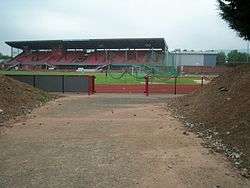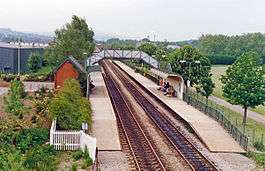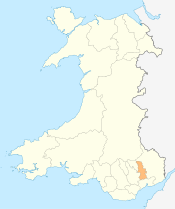Cwmbran
| Cwmbran | |
|---|---|
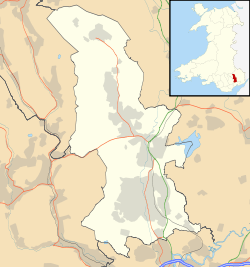 Cwmbran Cwmbran shown within Torfaen | |
| Population | 48,535 |
| OS grid reference | ST295955 |
| Principal area | |
| Ceremonial county | |
| Country | Wales |
| Sovereign state | United Kingdom |
| Post town | CWMBRAN |
| Postcode district | NP44 |
| Dialling code | 01633 |
| Police | Gwent |
| Fire | South Wales |
| Ambulance | Welsh |
| EU Parliament | Wales |
| UK Parliament | |
| Welsh Assembly | |
Cwmbran (/kʊmˈbrɑːn,
Comprising the villages of Old Cwmbran, Pontnewydd, Upper Cwmbran, Croesyceiliog, Llantarnam and Llanyrafon, its population had grown to 48,535 by 2011.[1] This makes it the sixth largest urban area in Wales.
History
Cwmbran is a new town which was established in 1949 to provide new employment opportunities in the south eastern portion of the South Wales Coalfield.
There is evidence that Neolithic and Bronze Age people used the area, with the Iron Age Silures tribe also occupying the region before being subdued by the Roman legions based at nearby Usk and Caerleon.
Around 1179, Hywel, Lord of Caerleon gave a gift of money and land to found the Cistercian abbey at Llantarnam. At the dissolution of the monasteries by Henry VIII the abbey was closed and was bought by a succession of wealthy landowners. By the 18th century the abbey had passed into the ownership of the Blewitt family, who were to become key figures in the early industrialisation of Cwmbran. Brick making, lime kilns, iron ore mining, quarrying and coal mining were established during this period, along with a canal to transport goods to the docks at Newport. In 1833 the Ordnance Survey map of Monmouthshire shows Cwmbran as a farm situated in the area now known as Upper Cwmbran, in the valley named Cwm Brân. Cwmbran now covers about 3,000 acres (12 km2) and has a population of around 50,000.
Following some investigation by local residents Richard Davies and Mike Price, the Ancient Cwmbran & The Cistercian project was created and a £48,000 grant has been provided by the Heritage Lottery Fund to explore some previously unrecorded sites of interest in the Greenmeadow and Thornhill areas.[2]
The Cistercian Way also passes through Llantarnam, Old Cwmbran, Greenmeadow and Thornhill before reaching the ancient chapel of Llanderfel on Mynydd Maen, and then onwards to Twmbarlwm.
In the 19th and 20th centuries, Cwmbran was the site of heavy industrial development. Coal and iron ore were extracted on Mynydd Maen, and moved by inclined planes and tramways into the Eastern Valley for use in factories such as the Patent Nut and Bolt Company (which became Guest Keen and Nettlefolds in 1900),[3] various tin plate works and brickworks. This industry drove the creation of the Monmouthshire Canal, the Newport and Pontypool Railway and the Pontypool, Caerleon and Newport Railway. Very little of this industrial heritage remains today, though many of today's light industrial or retail estates were created on the sites.
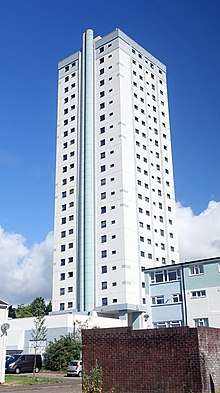
Following the 1946 New Towns Act, ministries and county councils were asked to nominate sites for housing. For Wales, the Ministry of Housing and Local Government proposed Church Village and Cwmbran. The Church Village proposal was vetoed by the Ministry of Power as new housing there would have interfered with plans for the expansion of coal mining in the area; however, Cwmbran was passed in 1949.[4]
Etymology
The name of the town derives from the Welsh "Cwm Brân", meaning "valley of the river Brân". This was the name of a village located in the valley, which had grown up around the tinplate works of the Cwmbran Iron Company. "Brân" means "crow", which could be allusion to the dark waters of the river, or may have been the personal name of someone associated with the area.[5]
Geography
Sitting as it does at the corner of the South Wales Coalfield, it has a hilly aspect to its western and northern edges, with the surrounding hills climbing to over 1,000 feet (300 m). The Afon Llwyd forms the major river valley, although the most significant water course is probably the remains of the Monmouthshire & Brecon Canal. To the east of Cwmbran the land is less hilly, forming part of the Usk valley.
Economy
The longest established employer in Cwmbran is biscuit maker Burton's Foods, who employ 1000 people to make its Jammie Dodgers and Wagon Wheels biscuits.[6] As of 2005, the Cwmbran plant produces over 400 million Wagon Wheels a year.[7]
Contour Aerospace (now owned by Zodiac Aerospace[8] opened a new factory in Cwmbran in 2000, and employed 1000 people manufacturing aircraft seats.
Cwmbran Centre
Constructed from 1959 to 1981, the pedestrianised Centre hosts supermarkets, high street retailers, banks, theatre, cinema, bowling alley, restaurants, creche, trampoline park, gym, police station, magistrates court, youth centre, pub, library, arts centre and office space. The 170+ shops can be accessed by the bus station located in the Centre, a train station a few minutes walk north-east or with the 3000 free parking spaces located around the Centre's ring road.
SME-businesses include the Cwmbran Brewery in Upper Cwmbran, which opened in 1996 as Cottage Spring Brewery.[9]
Education
The town has two secondary education schools: Croesyceiliog School and Cwmbran High School . There are numerous primary[10] and nursery schools including a Welsh medium primary school, Ysgol Gymraeg Cwmbrân.
Sport
Cwmbran Stadium[11] was home to international athletics events in the 1970s and 1980s. British athletics coach Malcolm Arnold used to train some of his athletes at Cwmbran in the 80s and early 90s while he was the Welsh National Coach. Athletes who trained there regularly under Malcolm include former World 110m Hurdle Champion and World Record Holder, Colin Jackson; Commonwealth 110m Hurdle medallist, Paul Gray; and Nigel Walker who had two sporting careers, first as an Olympic hurdler and then later as a Welsh rugby union international player. The 1999 World Indoor 400m Champion Jamie Baulch also used the stadium as a regular training track under a different coach. The stadium is also the home of the football teams, Cwmbran Town and Cwmbran Celtic as well as Cwmbran Men's Hockey Club and Cwmbran Ladies' Hockey Club (which are independent clubs).
The three main football teams in Cwmbran are Cwmbran Town, Cwmbran Celtic and Croesyceilog who all compete in the Welsh Football League.
Separate grounds at Pontnewydd and Croesyceiliog house the town's two rugby teams, Cwmbran RFC and Croesyceiliog RFC, although many more of the town's residents support the rugby teams of the older, adjacent town of Pontypool, the city of Newport and the Newport Gwent Dragons regional team.
Rugby league is represented in the town by Torfaen Tigers, who play in the fourth tier of the rugby league pyramid system, the Conference League South. They play their home matches at the Kings Head Ground, home of Cwmbran R.F.C.
The town has three athletics clubs: Cwmbran Harriers,[12] Fairwater Runners[13] and Griffithstown Harriers.[14]
Cwmbran also has several martial art clubs including a Shotokan Karate club (affiliated to the KUGB), which is part of the Wales-based Tekki Karate Academy. Junior karate is also available throughout Cwmbran via the Junior Karate Club. Apolaki Dirty Boxing[15] (the official South Wales branch affiliated to the Apolaki Krav Maga & Dirty Boxing Association[16]) is also available.
Also in Cwmbran was The Football Factory. Located near to the town centre, The Football Factory was an indoor sports complex consisting of two sports pitches. Sadly the building suffered a fire
Media
In July 2011, Cwmbran was the setting for Goldie Lookin Chain's satirical "Fresh Prince of Cwmbran", a song based on the Fresh Prince of Bel-Air theme praising the town.[17]
In early 2014, Torfonix Radio was established as an internet radio station.
Transport
Cwmbran railway station[18] is served by trains on the Welsh Marches Line,[19] with through trains south to Newport and Cardiff. Northbound local trains serve Pontypool and Abergavenny, with longer distance services running to Hereford, Shrewsbury, Crewe, Holyhead and Manchester. The station was not opened until 1986, as one of the last acts of the Cwmbran New Town Development Board.
Prior to this, Cwmbran had been without a train service for 24 years. Historically Cwmbran was served by 2 lines and several local stations: the first, opened in 1852, (largely taking the route of Cwmbran Drive today) was built by Monmouthshire Railway and Canal Company, whilst the line that remains in use today was opened by the Pontypool, Caerleon and Newport Railway in 1874.
The town has a comprehensive local bus service.
Notable people
- See also Category:People from Cwmbran
- Helen Adams, Big Brother Contestant/TV presenter/Hairdresser.
- Jamie Arthur, Commonwealth Games medal winning boxer.
- Ivor Bulmer-Thomas, sometime Member of Parliament and campaigner for the preservation of Churches.
- Lee Dainton, TV Show presenter of "Dirty Sanchez"
- Ceri Dallimore, Commonwealth Games Gold medal winning marks-woman.
- Kim & Michael Davies, Robot Wars UK competitors and champions with Panic Attack
- Andy Dibble, professional footballer
- Danny Gabbidon, professional footballer for Cardiff City and Wales.
- Green Gartside, born in Cardiff, singer with Scritti Politti
- Ian Gough, Newport Gwent Dragons, Ospreys and 64 capped Welsh International Rugby Union Player
- Denise Kingsmill, Baroness Kingsmill
- Gary Lockett, World title challenging boxer and TV/Radio analyst.
- Margaret Price, opera singer
- Rachel Rice, Big Brother winner
- Steven Nott, Leveson Inquiry witness 6 December 2011. Recognised by The Guardian's Nick Davies as the first person to try and expose the phone hacking scandal in 1999.
- Theo Wharton, Cardiff City Academy graduate and Wales youth international.
- John Williams (VC), real name John Fielding – Zulu War and Rorke's Drift veteran, born in Abergavenny, buried in Llantarnam.
Bibliography
- Village Publishing (1985). 'The trains don't stop here anymore....' – A pictorial history of Cwmbran from the 1930s to the present day. Village Publishing. ISBN 0-946043-07-8.
- Cwmbran & District Writers (2004). Cwmbran – And other Routes as the crow flies. ISBN 1-872730-34-5.
- Philip Riden (1988). Rebuilding a Valley. Cwmbran Development Corporation. ISBN 0-9510548-1-3.
References
- ↑
- ↑ "BBC - South East Wales - Uncovering history of a new town".
- ↑ "Archived copy". Archived from the original on 2012-11-19. Retrieved 2012-02-13.
- ↑ Why Cwmbran Archived 2012-03-17 at the Wayback Machine.
- ↑ "What's in a place name? Cwmbrân". BBC.
- ↑ "Burtons Foods Ltd, Cwmbran, Gwent on MacRAEs Blue Book UK Industrial Directory".
- ↑ "Archived copy". Archived from the original on 2010-02-08. Retrieved 2011-02-02.
- ↑ "Cwmbran airline seat firm Contour sold to Zodiac". 13 December 2011 – via www.bbc.co.uk.
- ↑ "Cwmbran Brewery". www.quaffale.org.uk. Retrieved 2009-08-10.
- ↑ "Geograph:: Fairwater Primary School, Henllys Way,... (C) Roger Cornfoot".
- ↑ "Geograph:: Cwmbran Stadium (C) David Luther Thomas".
- ↑ Cwmbranharriers.co.uk,
- ↑ "呉越同舟". www.fairwater-runners.co.uk.
- ↑ "Griffithstown Harriers running club".
- ↑ "Apolaki Dirty Boxing".
- ↑ http://www.apolakikravmagalondon.com Archived 2015-09-05 at the Wayback Machine.
- ↑ Sanders, Alison (29 July 2011). "GLC join our Buy Local campaign with rap in praise of Cwmbran". South Wales Argus. Retrieved 4 April 2017.
- ↑ "Geograph:: Railway station, Cwmbran (C) Roger Cornfoot".
- ↑ "Geograph:: Hereford train, near Cwmbran (C) Roger Cornfoot".
External links
| Wikimedia Commons has media related to Cwmbran. |
